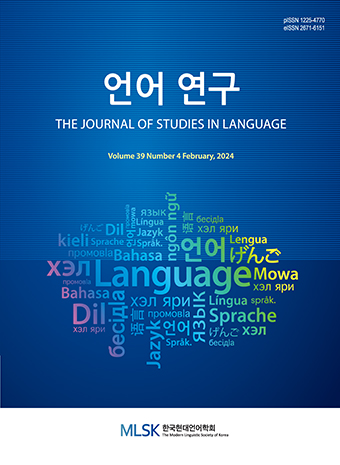Research Article
Abstract
References
Information
This study aims to test the Pre-voiceless Hyperarticulation Hypothesis of Thomas (2000) and Moreton (2004) for American English vowels [i, ɪ, eɪ, oʊ, aɪ, ɔɪ, aʊ]. Native and Korean-English bilingual speakers participated in a production experiment and read minimal pairs in the forms of “[bVd] - [bVt]” in a carrier sentence. As for the native speakers, the high front vowel [i] did not display significant peripheralization, and the lax [ɪ] tended to be centralized in the vowel space. Because the offglide [ɪ] of the diphthongs [eɪ, aɪ, ɔɪ] displayed peripheralization, the centralization of [ɪ] was interpreted as another type of hyperarticulation to maintain phonological contrast against [i] in the voiceless context. Bilingual speakers generally displayed smaller degrees of hyperarticulation or non-native- like formant patterns. It was interpreted that the learning of the fine-grained differences in the formant values according to the coda voicing has not been completed even for highly experienced learners of English.
- Bell-Berti, F. 1975. Control of pharyngeal cavity size for English voiced and voiceless stops. Journal of the Acoustical Society of America 57, 456-461. 10.1121/1.380468 1117099
- Boersma, P. and D. Weenink. 2016. Praat: Doing phonetics by computer. Software retrieved from [http://www.fon. hum.uva.nl/praat/].
- Chen, M. 1970. Vowel length variation as a function of the voicing of consonant environment. Phonetica 22, 129-159. 10.1159/000259312
- Choi, J., S. Kim, and T. Cho. 2016. Phonetic encoding of coda voicing contrast under different focus conditions in L1 vs. L2 English. Frontiers in Psychology 7, 1-17. 10.3389/fpsyg.2016.00624
- Crowther, C. S. and V. Mann. 1992. Native-language factors affecting use of vocalic cues to final-consonant voicing in English. Journal of the Acoustical Society of America 92, 711-722. 10.1121/1.403996 1506526
- Gay, T. 1968. Effect of speaking rate on diphthong formant movements. Journal of the Acoustical Society of America 44, 1570-1573. 10.1121/1.1911298 5702031
- Gay, T. 1978. Physiological and acoustic correlates of perceived stress. Language and Speech 21, 347-353. 10.1177/002383097802100409 750794
- Gottfried, M., J. D. Miller, and D. J. Meyer. 1993. Three approaches to the classification of American English diphthongs. Journal of Phonetics 21, 205-229. 10.1016/S0095-4470(19)31337-3
- Guion, S. G. 2003. The vowel systems of Quichua-Spanish bilinguals: Age of acquisition effects on the mutual influence of the first and second language. Phonetica 60, 98-128. 10.1159/000071449 12853715
- Keating, P. 1985. Universal phonetics and the organization of grammars. In V. Fromkin (ed.), Phonetic Linguistics. Academic Press, 115-132.
- Lindblom, B. 1963. Spectrographic study of vowel reduction. Journal of the Acoustical Society of America 35, 1773-1781. 10.1121/1.1918816
- Lindblom, B. 1986. Phonetic universals in vowel systems. In J. J. Ohala, and J. J. Jaeger (eds.), Experimental Phonology. Academic Press, 13-44.
- Lindblom, B. and J. Sundberg. 1971. Acoustical consequences of lip, tongue, jaw, and larynx movement. Journal of the Acoustical Society of America 50, 1166-1179. 10.1121/1.1912750 5117649
- Moreton, E. 2004. Realization of the English postvocalic [voice] contrast in F1 and F2. Journal of Phonetics 32, 1-33. 10.1016/S0095-4470(03)00004-4
- Oh, E. 2018. Spectral patterns of the American English diphthong /aɪ/ as a function of coda voicing produced by native Korean speakers. Linguistic Research 35, 179-201. 10.17250/khisli.35.1.201803.007
- Peterson, G. E. and I. Lehiste. 1960. Duration of syllable nuclei in English. Journal of the Acoustical Society of America 32, 693-703. 10.1121/1.1908183
- Pycha, A. and D. Dahan. 2016. Differences in coda voicing trigger changes in gestural timing: A test case from the American English diphthong /aɪ/. Journal of Phonetics 56, 15-37. 10.1016/j.wocn.2016.01.002 26966337 PMC4780424
- Riordan, C. J. 1980. Larynx height during English stop consonants. Journal of Phonetics 3, 353-360. 10.1016/S0095-4470(19)31485-8
- Summers, W. V. 1987. Effects of stress and final-consonant voicing on vowel production: Articulatory and acoustic analysis. Journal of the Acoustical Society of America 82, 847-863. 10.1121/1.395284 3655120
- Summers, W. V. 1988. F1 structure provides information for final-consonant voicing. Journal of the Acoustical Society of America 84, 485-492. 10.1121/1.396826 3170941
- Thomas, E. R. 2000. Spectral differences in /ai/ offsets conditioned by voicing of the following consonant. Journal of Phonetics 28, 1-25.10.1006/jpho.2000.0103
- Wolf, C. G. 1978. Voicing cues in English final stops. Journal of Phonetics 6, 299-309.10.1016/S0095-4470(19)31162-3
- Publisher :The Modern Linguistic Society of Korea
- Publisher(Ko) :한국현대언어학회
- Journal Title :The Journal of Studies in Language
- Journal Title(Ko) :언어연구
- Volume : 36
- No :3
- Pages :329-347
- DOI :https://doi.org/10.18627/jslg.36.3.202011.329




 The Journal of Studies in Language
The Journal of Studies in Language






